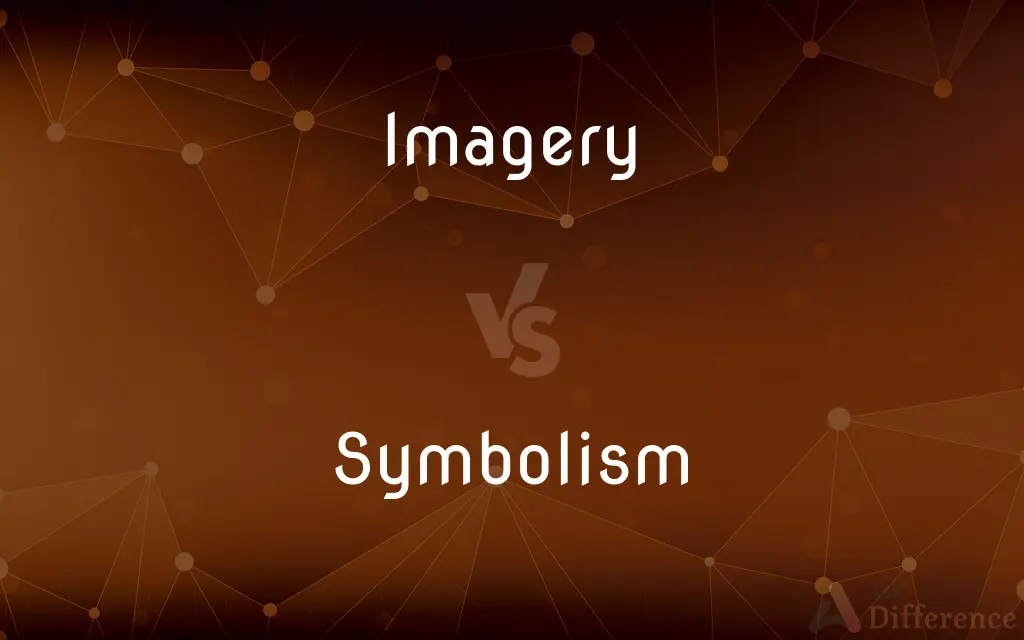Imagery vs. Symbolism — What's the Difference?
Edited by Tayyaba Rehman — By Urooj Arif — Updated on March 13, 2024
Imagery involves descriptive language that appeals to the senses, painting vivid pictures in the reader's mind, while symbolism uses objects, figures, or colors to represent deeper meanings or concepts beyond their literal sense.

Difference Between Imagery and Symbolism
Table of Contents
ADVERTISEMENT
Key Differences
Imagery is a literary device that authors use to create strong, vivid pictures or express sensations in the reader’s mind, using detailed descriptions that appeal to the senses (sight, sound, smell, touch, taste). Symbolism, on the other hand, involves imbuing objects, figures, colors, or even actions with meanings that transcend their literal existence.
While imagery aims directly at the reader's senses to create an immersive reading experience, symbolism seeks to engage the reader's intellect and emotions on a more symbolic and often abstract level. Imagery is about creating vivid pictures and sensations, whereas symbolism is about representing broader themes, messages, or emotions through the use of specific symbols.
The two can overlap, with imagery sometimes serving as a vehicle for symbolism. A detailed, sensory-rich description of an object or scene (imagery) can also carry symbolic meaning, enriching the narrative with deeper layers of interpretation. For example, a decaying house described in vivid detail (imagery) might also symbolize the decline of a family or society (symbolism).
In essence, imagery and symbolism are complementary tools in literature that serve different purposes: imagery enhances the immediacy and sensory richness of the text, while symbolism adds depth and layers of meaning, inviting reflection and interpretation.
Comparison Chart
Definition
Use of descriptive language to evoke sensory experiences.
Use of objects, figures, or colors to represent deeper meanings.
ADVERTISEMENT
Purpose
To paint vivid pictures in the reader's mind.
To convey complex ideas or themes beyond their literal sense.
Appeal
Directly to the senses (visual, auditory, etc.).
To intellect and emotions through abstract concepts.
Examples
Describing a sunset in detail to evoke its beauty.
A chain representing bondage or lack of freedom.
Role
Enhances the immediacy and sensory richness of the text.
Adds depth and layers of meaning to the narrative.
Compare with Definitions
Imagery
Sensory description of a lush garden.
The garden burst with colors, fragrant roses, and the buzzing of bees.
Symbolism
A dove representing peace.
The dove flew over the battlefield, a lone symbol of peace amidst chaos.
Imagery
Illustration of a serene lake.
The lake was a mirror, reflecting the soft hues of the dusk sky.
Symbolism
The color black denoting death or evil.
The black cloak he wore seemed to absorb all light, a shadow of death.
Imagery
Expression of intense emotion.
His heart felt like it was encased in ice, cold and numb.
Symbolism
A crossroad symbolizing a crucial decision.
Standing at the crossroad, she realized it was more than a choice of path; it was a choice of destiny.
Imagery
Vivid portrayal of a stormy sea.
The angry waves crashed against the ship, spraying salty foam in the air.
Symbolism
Chains symbolizing oppression.
The chains were not just physical but also represented the oppression they faced.
Imagery
Depiction of a bustling city street.
The city street was alive with the sound of vendors and the aroma of street food.
Symbolism
A broken mirror as a symbol of bad luck or fragmentation.
The broken mirror on the floor was an ominous sign of misfortune.
Imagery
Part of the figurative language in a literary work, whereby the author uses vivid images to describe a phenomenon
Symbolism
The practice of representing things by means of symbols or of attributing symbolic meanings or significance to objects, events, or relationships.
Imagery
Visually descriptive or figurative language, especially in a literary work
Tennyson uses imagery to create a lyrical emotion
Symbolism
A system of symbols or representations.
Imagery
Visual images collectively
The impact of computer-generated imagery on contemporary art
Symbolism
A symbolic meaning or representation.
Imagery
A set of mental pictures or images.
Symbolism
Revelation or suggestion of intangible conditions or truths by artistic invention.
Imagery
The use of vivid or figurative language to represent objects, actions, or ideas.
Symbolism
Symbolism The movement, theory, or practice of the late 19th-century Symbolists.
Imagery
The use of expressive or evocative images in art, literature, or music.
Symbolism
Representation of a concept through symbols or underlying meanings of objects or qualities.
Imagery
A group or body of related images, as in a painting or poem.
Symbolism
(obsolete) A combining together of parts or ingredients.
Imagery
Representative images, particularly statues or icons.
Symbolism
The act of symbolizing, or the state of being symbolized; as, symbolism in Christian art is the representation of truth, virtues, vices, etc., by emblematic colors, signs, and forms.
Imagery
The art of making such images.
Symbolism
A system of symbols or representations.
Imagery
(Psychology) A technique in behavior therapy in which the patient uses pleasant fantasies to relax and counteract anxiety.
Symbolism
The practice of using symbols, or the system of notation developed thereby.
Imagery
The work of one who makes images or visible representation of objects.
Symbolism
The science of creeds; symbolics.
Imagery
Imitation work.
Symbolism
A system of symbols and symbolic representations
Imagery
Images in general, or en masse.
Symbolism
The practice of investing things with symbolic meaning
Imagery
(figuratively) Unreal show; imitation; appearance.
Symbolism
An artistic movement in the late 19th century that tried to express abstract or mystical ideas through the symbolic use of images
Imagery
The work of the imagination or fancy; false ideas; imaginary phantasms.
Imagery
Rhetorical decoration in writing or speaking; vivid descriptions presenting or suggesting images of sensible objects; figures in discourse.
Imagery
The work of one who makes images or visible representation of objects; imitation work; images in general, or in mass.
In those oratories might you seeRich carvings, portraitures, and imagery.
Imagery
Fig.: Unreal show; imitation; appearance.
What can thy imagery of sorrow mean?
Imagery
The work of the imagination or fancy; false ideas; imaginary phantasms.
The imagery of a melancholic fancy.
Imagery
Rhetorical decoration in writing or speaking; vivid descriptions presenting or suggesting images of sensible objects; figures in discourse.
I wish there may be in this poem any instance of good imagery.
Imagery
The ability to form mental images of things or events;
He could still hear her in his imagination
Common Curiosities
Can imagery and symbolism be used together?
Yes, imagery can serve as a vehicle for symbolism, where detailed descriptions not only create vivid sensory experiences but also carry deeper symbolic meanings.
How does symbolism work in literature?
Symbolism works by using objects, figures, or colors to represent deeper meanings or concepts beyond their literal sense, adding layers of meaning to the narrative.
What role does symbolism play in storytelling?
Symbolism adds depth and complexity to storytelling, allowing authors to convey themes, ideas, and emotions in a more nuanced and indirect manner.
Why is imagery important in writing?
Imagery is important because it enhances the reader's experience, making the text more vivid and engaging by appealing directly to the senses.
Is imagery purely visual?
While often visual, imagery can also appeal to other senses, including auditory, olfactory (smell), tactile (touch), and gustatory (taste), to create a full sensory experience.
How do readers interpret symbolism?
Readers interpret symbolism by considering the context and the broader themes of the work, using their insight and imagination to uncover the deeper meanings behind symbols.
What is imagery in literature?
Imagery refers to the use of descriptive language to evoke sensory experiences, creating vivid pictures in the reader’s mind.
How does symbolism enhance reader engagement?
Symbolism enhances reader engagement by inviting deeper reflection and interpretation, making the reading experience more intellectually and emotionally enriching.
Can any object become a symbol in literature?
Yes, any object can become a symbol in literature if the author imbues it with meaning that transcends its literal sense, making it a conduit for deeper themes and ideas.
Can the same object symbolize different things?
Yes, the same object can symbolize different things in different contexts, depending on how it is used by the author and interpreted by the reader.
Share Your Discovery

Previous Comparison
Unironically vs. Ironically
Next Comparison
Ascot vs. BandanaAuthor Spotlight
Written by
Urooj ArifUrooj is a skilled content writer at Ask Difference, known for her exceptional ability to simplify complex topics into engaging and informative content. With a passion for research and a flair for clear, concise writing, she consistently delivers articles that resonate with our diverse audience.
Edited by
Tayyaba RehmanTayyaba Rehman is a distinguished writer, currently serving as a primary contributor to askdifference.com. As a researcher in semantics and etymology, Tayyaba's passion for the complexity of languages and their distinctions has found a perfect home on the platform. Tayyaba delves into the intricacies of language, distinguishing between commonly confused words and phrases, thereby providing clarity for readers worldwide.















































